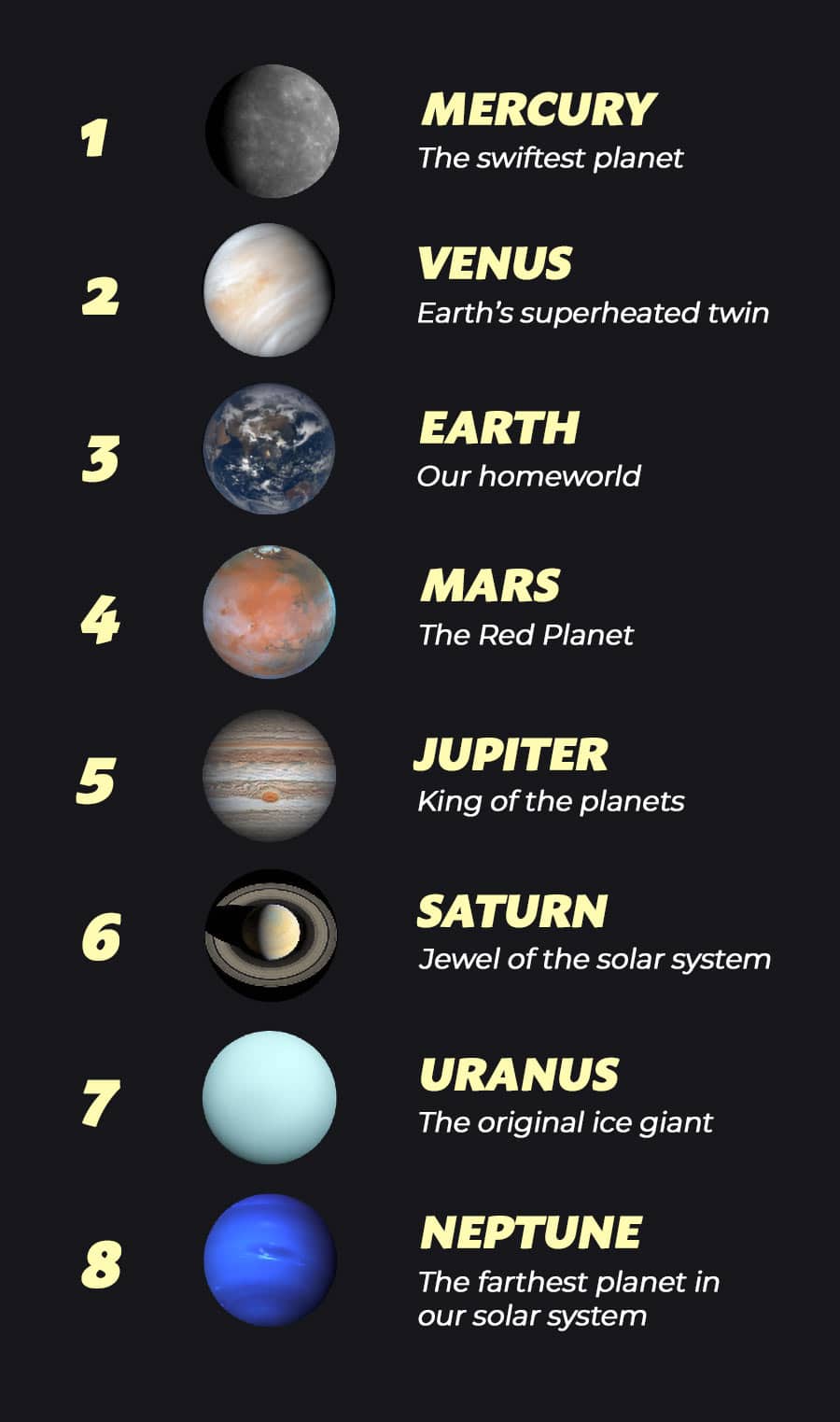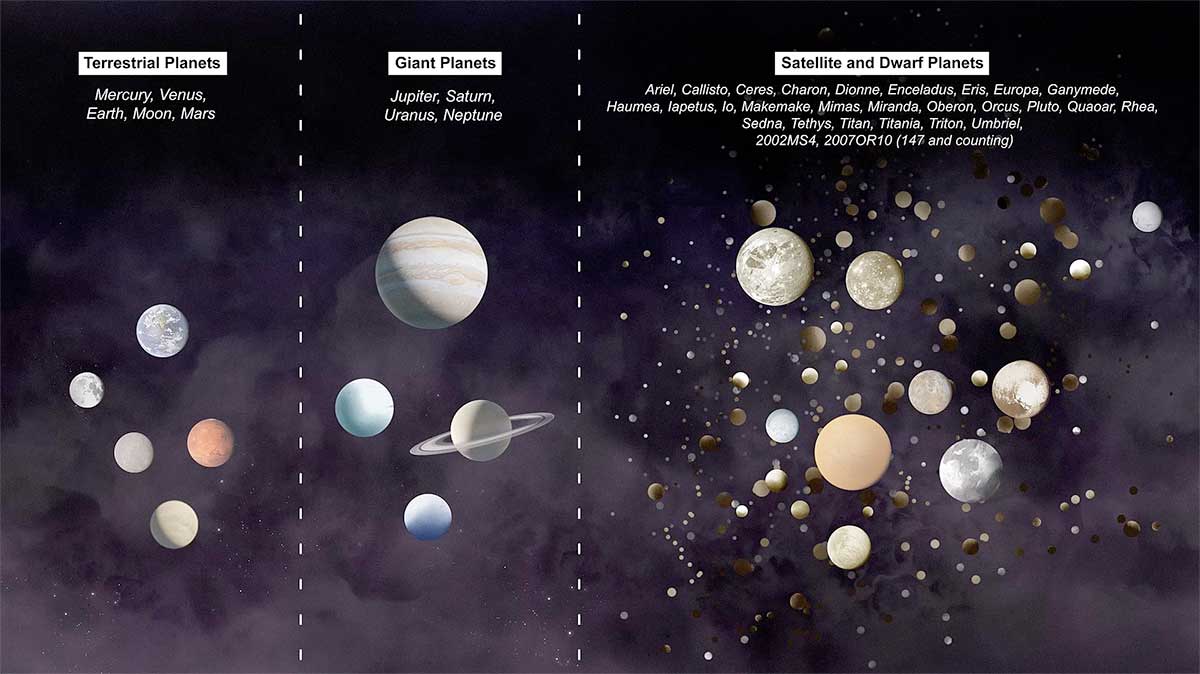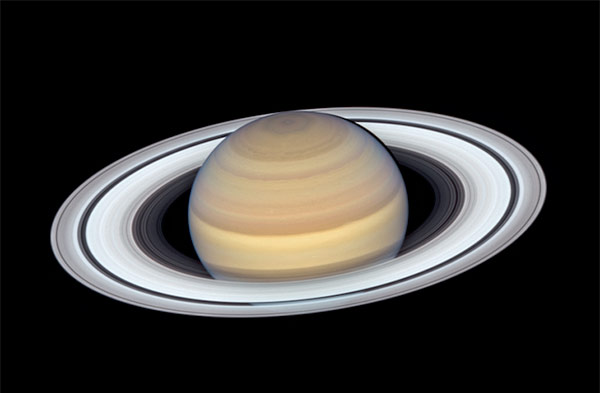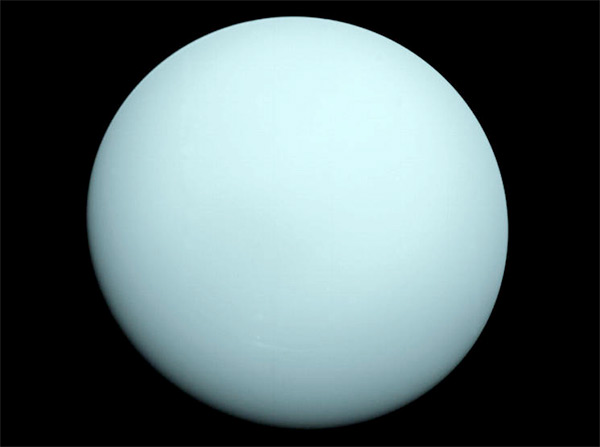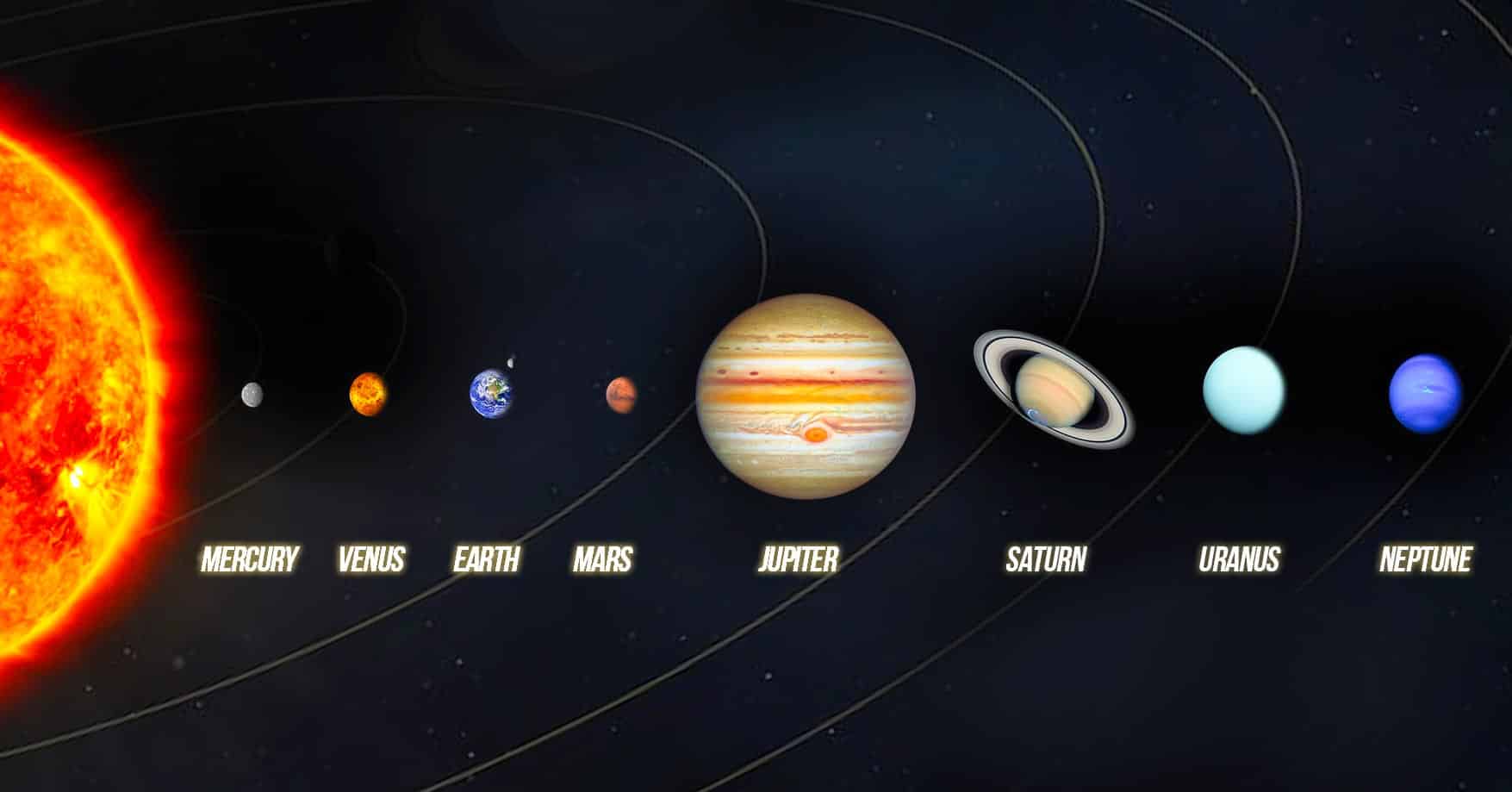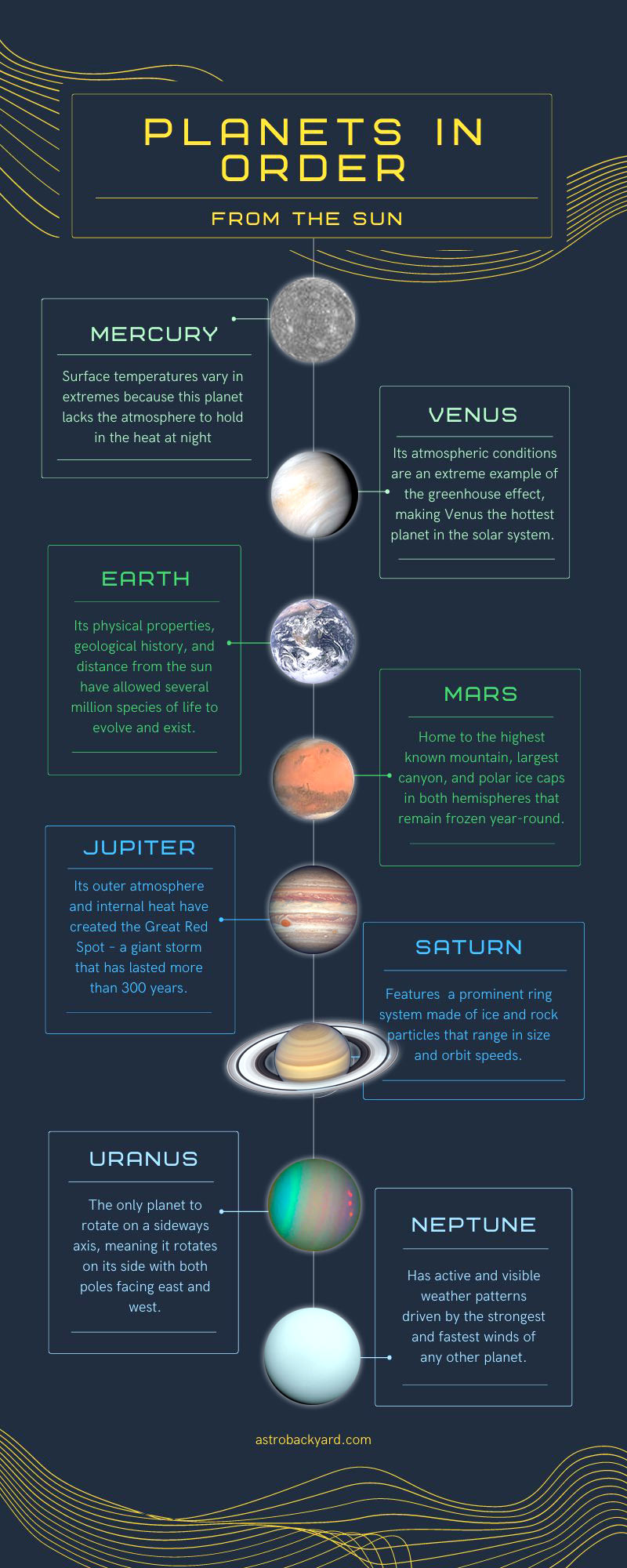Planets in Order From the Sun
Our solar system is located in the Orion spiral arm of the Milky Way Galaxy and contains eight official planets that orbit counterclockwise around the Sun. The order of the eight official solar system planets from the Sun, starting closest and moving outward is:
The planets in order from the Sun. Image created using IAU/ NASA APOD.
In addition to the planets, our solar system also includes dwarf planets, moons, asteroids, comets, and meteoroids.
Our planetary system is the only official solar system in the Universe, but astronomers continue to find thousands of other stars with planets orbiting them in our galaxy.
Without the sun’s gravity, every planet and object in the solar system would drift randomly into space. The Sun provides life-giving light, heat, and energy to Earth.
In this article, I’ll provide useful information about each planet in our solar system, and explain why Pluto is considered a ‘dwarf planet’.
How to Remember the Planets in Order
Even though there are only 8 official planets in the solar system, it can be tricky to remember them all in order from the Sun. A popular technique to use a mnemonic, which can be any sentence you want using the first letter of each planet.
The letters for each word in the sentence must be M, V, E, M, J, S, U, and N.
Here are a few examples of mnemonics for remembering the planet’s names in order from the Sun. Feel free to create your own sentence that is easy to remember.
- My Very Easy Method Just Speeds Up Names
- My Very Educated Mother Just Served Us Nachos
- Mom Visits Every Month Just Stays Until Noon
- My Very Excellent Mother Just Served Up Noodles
What is the Definition of a Planet?
There is an ongoing debate about the number of planets in our solar system. The most recent definition of a planet was released in 2006 by the International Astronomical Union (IAU), an organization responsible for classifying astronomical objects.
Their definition requires a planet to:
- Orbit around the Sun
- Have enough gravity to force it into a spherical shape
- Have cleared away any other objects of similar size near its orbit around the Sun
The Definition Debate
Not all astronomers and planetary scientists agreed with the definitions, with some seeing them as limiting the number of planets and others finding them incomplete and confusing.
Certain astronomers stressed the importance of considering the context for understanding the solar system’s formation and evolution. One proposed idea suggested defining a planet simply as a space object shaped into a roughly spherical form by gravity.
However, objections were raised regarding the specific degree of roundness needed for qualification and the challenges of accurately determining the shapes of distant objects.
Some argue for including factors like an object’s location and composition in defining a planet, considering its dynamics and orbital stability.
The ongoing debate over planet classification persists amidst our expanding knowledge of the universe, which includes the discovery of numerous exoplanets, potentially including habitable ones within the Milky Way Galaxy, raising questions about the applicability of our current definitions.
Compared to the IAU planet definition, planetary scientist Alan Stern’s 2018 definition excludes the first point (that a planet be in orbit around the sun) and the third point (that a planet has cleared the neighborhood around its orbit). Stern’s definition thus counts dwarf planets and planetary-mass moons as planets.
The Planet Definition Debate. Alan Stern and Ron Ekers.
Many professionals in the field also criticize the IAU definition of trying to limit the number of planets with the most recent change to the definition, as it was ultimately responsible for Pluto being removed as the ninth planet and re-labeled a dwarf planet.
The IAU currently recognizes five dwarf planets:
- Ceres
- Pluto
- Haumea
- Makemake
- Eris
Based on the geophysical definition of a planet, there are several satellite and dwarf planets in the solar system, and likely more that haven’t been discovered.
Geophysical classification of planets. Johns Hopkins APL/Mike Yakovlev
Categories of Planets
All planets and dwarf planets recognized by the IAU will be included and separated into three categories of planets; Terrestrial, Giant, and Dwarf planets.
- Terrestrial Planets: Mercury, Venus, Earth, and Mars
- Giant Planets: Jupiter, Saturn, Uranus, Neptune
- Dwarf Planets: Ceres, Pluto, Haumea, Makemake, Eris
These categories help astronomers and scientists classify and understand the diverse range of celestial bodies found within our solar system and beyond.s)
Terrestrial and Giant Planets in order from the Sun
Terrestrial Planets
Terrestrial planets include the four closest planets to the Sun located between the Sun and the asteroid belt; Mercury, Venus, Earth, and Mars. Astronomers who use the geophysical definition of a planet would also include the Moon as a terrestrial planet.
Terrestrial planets are planets with a solid surface, often made up of rock or metals. These types of planets also have few moons, a molten core, and can have surface features like valleys, mountains, and volcanoes.
The terrestrial planets: Mercury, Venus, Earth, and Mars, sized to scale.
The Solar System
The solar system encompasses planets, moons, asteroids, comets, and dwarf planets, that orbit around the Sun at its center. The solar system was created about 4.6 billion years ago in a collapsing cloud of gas and dust that eventually flattened into a rotating disk.
The two main regions of the solar system are the inner and outer solar systems. The inner planets orbit relatively close to the Sun and have solid surfaces. The outer solar system is where the gas giants reside.
The solar system is always evolving as celestial bodies interact with each other through gravitational forces. Understanding the solar system helps us better understand Earth’s origins and the formation of other planetary systems throughout the universe.
The 8 primary planets of the solar system. (MARK GARLICK/SCIENCE PHOTO LIBRARY via Getty Images)
Let’s take a closer look at each of the 8 largest celestial bodies that orbit the sun, the planets. We’ll start with the closest planet to the sun and work our way out to the distant outer solar system objects.
Mercury
Mercury is the closest planet to the Sun and is the smallest of the eight planets being only slightly larger than our moon. Mercury’s surface temperatures vary in extremes reaching day temperatures as high as 800°F (430°C) and dipping as low as -290°F (-180°C), lacking the atmosphere to hold the heat at night.
One day lasts a long time on Mercury since the planet spins slowly – it takes 59 Earth days to make one full rotation. However, a year on Mercury goes fairly fast due to the proximity to the Sun. It takes only 88 Earth days, making it the fastest planet to orbit the Sun.
Two spacecraft have visited Mercury, including Mariner (1974/75) and Messenger (launched in 2004). Messenger orbited Mercury over 4,000 times in four years then crashed into the planet’s surface after running out of fuel. In 2016, scientists released the first digital-elevation model of Mercury, which combined more than 10,000 images acquired by Messenger.
- Diameter: 3,031 miles or 4,878 km
- Distance from the Sun: 0.4 Astronomical Units (AU)
- Day: 59 Earth days
- Orbit: 88 Earth days
- Natural Satellites: None
Mariner 10 image of Mercury. NASA
Interesting Facts About Mercury
- A year on Mercury is equivalent to 88 Earth days, making it the shortest year of any planet in the solar system
- A day on Mercury ( the time it takes to rotate once on its axis) is longer than its year! (176 Earth days)
- Mercury experiences extreme temperature variations, from 800 degrees Fahrenheit during the day to -290 degrees Fahrenheit at night.
- Unlike other planets in our solar system, Mercury does not have any moons or rings.
- Mercury has a very thin atmosphere composed mostly of oxygen, sodium, hydrogen, helium, and potassium.
- Mercury’s surface is heavily cratered. The craters were formed by impacts from asteroids and comets over billions of years.
Above: I show my wife Ashley the planet, Mercury, for the first time using binoculars.
Venus
Venus is the second planet from the Sun and is the second-brightest natural object in Earth’s night sky after the Moon. It is similar to Earth in size and mass and is known as Earth’s sister or twin planet. Venus’s rotation period of 243 Earth days is slower than any other planet and is one of two planets to rotate in the opposite direction (east to west).
Venus’ atmospheric conditions are an extreme example of the greenhouse effect. Its thick, toxic atmosphere traps its heat resulting in temperatures upwards of 880 degrees Fahrenheit (471 degrees Celsius), making Venus the hottest planet in the solar system.
Due to these atmospheric conditions, detailed explorations of Venus are difficult. It was the first planet visited by a spacecraft (Mariner 2) and the first to be successfully landed on (Venera 7) but the first detailed maps were not possible until the arrival of Magellan in 1991.
- Diameter: 7,521 miles or 12,104 km
- Distance from Sun: 0.7 AU
- Day: 241 Earth days
- Orbit: 225 Earth days
- Natural Satellites: None
Image of Venus using data from NASA’s Magellan spacecraft and Pioneer Venus Orbiter. NASA
Interesting Facts About Venus
- Venus is the hottest planet in our solar system with surface temperatures that can exceed 880 degrees Fahrenheit due to its thick atmosphere.
- The atmosphere on Venus is dense and toxic. It is composed mostly of carbon dioxide with clouds of sulfuric acid.
- On Venus, the Sun rises in the west and sets in the east. Unlike most other planets in the solar system, Venus rotates on its axis in the opposite direction.
- Venus experiences extremely high-speed winds in its upper atmosphere, reaching speeds of up to 200 miles per hour.
Earth
Earth is the third planet from the Sun and it is the fifth-largest planet. Earth’s orbit around the Sun is 365.25 days, rotating on a tilted axis which is responsible for the four seasons. Earth’s gravity interacts with the Moon, its only natural satellite, helping to stabilize Earth’s axis orientation and slows its rotation causing tides.
Approximately 29% of the Earth’s surface is land (i.e. continents and islands) with the remaining 71% covered with water (i.e. oceans, lakes, rivers, and freshwater). Earth’s outer layer consists of several tectonic plates with a solid inner core and a liquid outer core. Earth’s atmosphere is rich in nitrogen and oxygen and several other gases in smaller amounts.
Earth’s distance from the Sun, physical properties, and geological history have allowed life to evolve and exist on Earth. There are several million species of life on our planet with scientists believing there are more species that have yet to be discovered.
- Diameter: 7,926 miles (12,760 km)
- Distance from Sun: 1 AU
- Day: 23 hours, 56 minutes
- Orbit: 365.25 Earth days
- Natural Satellites: the Moon
Image of Earth. NASA
Interesting Facts About Earth
- Earth is known as ‘The Blue Planet’ because about 71% of the surface is covered by water.
- Earth’s atmosphere is composed of nitrogen (about 78%) and oxygen (about 21%), with small amounts of other gases.
- Earth’s magnetic field is created by its iron-nickel core. Our magnetic field protects the planet from harmful solar radiation.
- Earth’s Moon plays an important role in stabilizing the planet’s axial tilt. It also creates ocean tides through gravitational forces.
- Earth’s oceans are incredibly deep. The deepest point is in the Mariana Trench, reaching depths of over 36,000 feet.
Mars
Mars is the fourth planet from the Sun, known as the Red Planet from iron oxide (rust) in the soil. Mars is home to the highest known mountain and largest canyon and polar ice caps in both hemispheres that remain frozen year-round.
Due to its low atmospheric pressure, liquid water cannot exist on its surface, except at the lowest elevations for short periods. Surface features and data from space missions have led scientists to believe that water might have flowed along the surface of Mars and may still be inside underground rock. Scientific evidence also suggests Mars was once a much warmer planet.
Mars is one of the most explored planets in the solar system including missions to assess the habitability and possibility of life on Mars. The first spacecraft to visit Mars (Mariner 4), captured the first images of another planet from space.
Viking 1 was the first spacecraft to successfully land on the surface of Mars, and Sojourner, part of the Mars Pathfinder spacecraft, was the first robotic rover to operate on Mars. Additional astrobiology missions are planned with the Perseverance and Rosalind Franklin rovers.
- Diameter: 4,217 miles (6,787 km)
- Distance from Sun: 1.5 AU
- Day: 24 hours, 37 minutes
- Orbit: 687 Earth days
- Natural Satellites: Deimos and Phobos
Mosaic of the Valles Marineris hemisphere of Mars. NASA
Interesting Facts About Mars
- Mars is known as “The Red Planet” because of its reddish appearance caused by the iron oxide on its surface.
- A day on Mars is a little bit longer than a day on Earth. It lasts about 24 hours and 37 minutes.
- There are polar ice caps on Mars, composed of water ice and frozen carbon dioxide.
- Mars is home to the tallest volcano in the solar system, Olympus Mons.
- Scientists believe that Mars once had liquid water on its surface billions of years ago, and some of it may still exist underground.
Above: I photograph the planet Mars as it approached opposition in 2020.
Giant Planets
Giant planets, also known as Jovian planets, are massive planets with a thick hydrogen and helium atmosphere, usually made of low-boiling-point materials (i.e. gases or ice). This includes Jupiter, Saturn, Uranus, and Neptune.
Jupiter and Saturn (the gas giants) are made up of mostly hydrogen and helium, whereas Uranus and Neptune are mostly composed of water, ammonia, and methane and are often referred to as ‘ice giants’.
Jupiter and Saturn are the largest planets in the solar system.
Uranus and Neptune also have hazy atmospheric layers with small amounts of methane, giving them aquamarine colors.
The four giant planets: Jupiter, Saturn, Uranus, and Neptune. Universe Today.
Jupiter
Jupiter is the fifth planet from the Sun, the largest planet in our solar system, and one of the brightest objects visible to the naked eye. It is composed mostly of hydrogen and helium with other trace gases. The outer atmosphere and internal heat have created cloud bands and the Great Red Spot – a giant storm that has lasted more than 300 years. Jupiter also has three faint rings that surround the planet.
Jupiter also spins faster than any other planet, taking a little under 10 hours to complete a turn on its axis, compared with 24 hours for Earth. Jupiter’s four largest moons, known as the Galilean satellites (Ganymede, Callisto, Io, and Europa), show similarities to the terrestrial planets.
There have been several fly-by missions of Jupiter, including Pioneer 10, Pioneer 11, Voyager 1, Voyager 2, Ulysses, Cassini, and New Horizons.
These missions provided data on the Great Red Spot, revealed volcanoes on Io, helped create the first detailed maps of the Galilean satellites, discovered Jupiter’s rings, and provided close-up photos of the planet and largest moons. Future exploration will include the ice-covered liquid ocean of the moon Europa.
- Diameter: 86,881 miles (139,822 km)
- Distance from Sun: 5.2 AU
- Day: 9.8 Earth hours
- Orbit: 11.9 Earth years
- Natural Satellites: 79
Images of Jupiter, taken by NASA’s Hubble Space Telescope. NASA, ESA, and A. Simon
Interesting Facts About Jupiter
- Jupiter is the largest planet in our solar system. it is more than 11 times wider than Earth.
- Jupiter is composed mainly of hydrogen and helium and does not have a solid surface.
- Jupiter has over 80 known moons, more than any other planet in our solar system.
- Jupiter’s strong gravitational pull influences the orbits of nearby objects in the solar system. It helps protect the inner solar system from potential impacts.
- Jupiter’s moons Europa and Ganymede have subsurface oceans that have conditions with the potential to support life.
Saturn
Saturn, also known as the ringed planet, is the sixth planet from the sun and the second-largest planet. Saturn is pale yellow due to ammonia crystals in its upper atmosphere and features a prominent ring system made of ice and rock particles that range in size and orbit speeds. The rings are roughly 20 meters (66ft.) thick and extend from 6,630 to 120,700 km (4,120 to 75,000 mi) from the equator.
Saturn has the second shortest day in the solar system taking only 10.7 hours to complete a full rotation. Similar to Earth, Saturn has a tilted orbital axis meaning Saturn also experiences seasons. Of Saturn’s approximately 60 moons, two of them (Titan and Enceladus) show signs of geological activity.
The Cassini spacecraft was the largest interplanetary spacecraft ever built and spent more than ten years orbiting Saturn, including flybys of Venus, Earth and Jupiter. The mission ended in 2017 when it was low on fuel and was intentionally burned up in Saturn’s atmosphere to avoid the risk of contaminating Saturn’s moon.
During the end of its mission, Cassini traveled between the planet and the inner rings bringing it closer to Saturn than any other spacecraft.
- Diameter: 74,900 miles (120,500 km)
- Distance from Sun: 9.5 AU
- Day: 10.5 Earth hours
- Orbit: 29.5 Earth years
- Natural Satellites: 62
Image of Saturn from the Hubble Space Telescope. NASA, ESA, A. Simon, M.H. Wong and the OPAL Team.
Interesting Facts About Saturn
- Saturn’s rings are made of ice and dust particles and are only a few hundred meters thick.
- Saturn’s largest moons include Titan, Rhea, Enceladus, and Mimas. Only Jupiter has more moons than Saturn.
- The Cassini spacecraft discovered a hexagonal-shaped storm at Saturn’s north pole.
- Saturn spins very quickly on its axis. It completes one full rotation in about 10.7 hours.
- Titan (Saturn’s largest moon) is the only moon in the solar system known to have a substantial atmosphere.
Above: I photograph the planet Saturn using an 11″ telescope in my backyard.
Uranus
Uranus is the seventh planet from the Sun and like Venus, rotates in the opposite direction as the other planets. Uranus is also the only planet to rotate on a sideways axis, meaning it rotates on its side with both poles facing east and west.
Like the other giant planets, Uranus also has 13 faint rings, although the outer rings are more brightly colored and easier to see.
Uranus’ tilted axis. Space.com (Image credit: NASA and Erich Karkoschka, U. of Arizona)
Uranus’ atmosphere contains gases similar to Jupiter and Saturn in addition to water, ammonia, and methane. The unique sideways tilt means that for nearly 84 Earth years the Sun shines directly over each pole and the opposite half of the planet experiences long, dark winters. It is the coldest atmosphere in the solar system with a minimum temperature of 49 K (−224 °C; −371 °F).
Voyager 2 remains the only investigation of Uranus, studying the structure and composition of the atmosphere, moons, and rings while also making additional discoveries. Voyager made its closest approach to the top of the clouds in 1986, before continuing to Neptune.
In 2009, an extension of the Cassini spacecraft mission to Uranus was evaluated but was rejected to move forward with destroying it in Saturn’s atmosphere. The extension would have taken Cassini 20 years to get to Uranus from Saturn.
- Diameter: 31,763 miles (51,120 km)
- Distance from Sun: 19.2 AU
- Day: 18 Earth hours
- Orbit: 84 Earth years
- Natural Satellites: 27
Image of Uranus taken by the spacecraft Voyager 2. NASA/JPL-Caltech.
Interesting Facts About Uranus
- Uranus is the coldest planet in our solar system, with temperatures as cold as -371 degrees Fahrenheit.
- Uranus’ atmosphere is composed mainly of hydrogen and helium, with traces of methane.
- The blue-green color of the planet Uranus is due to the methane in its upper atmosphere.
- Uranus has a ring system that is much fainter and less prominent than Saturn’s.
- Uranus has at least 27 known moons, including Miranda, Ariel, Umbriel, Titania, and Oberon.
- Uranus takes 84 Earth years to make a complete orbit around the Sun.
Neptune
Neptune is the eighth and farthest planet in our solar system. It is the fourth-largest planet and is similar to Uranus consisting of gases, ices, and has a series of moons and faint rings. Neptune was also the only planet whose presence was predicted using mathematics before it was observed visually through a telescope. This prediction was based largely on the changes in the orbit of Uranus.
Neptune has active and visible weather patterns driven by the strongest and fastest winds of any other planet in the solar system, reaching up to 1,500 mph (2,400 km/h). Neptune’s outer atmosphere is one of the coldest places in the solar system.
Voyager 2 is the only spacecraft to have visited Neptune, with a flyby in 1989. The mission confirmed the faint ring system that was discovered a few years earlier. Since the Voyager mission, additional observations continue to be made from ground-based telescopes.
- Diameter: 30,775 miles (49,530 km)
- Distance from Sun: 30.1 AU
- Day: 19 Earth hours
- Orbit: 165 Earth years
- Natural Satellites: 14
Image of Neptune was taken by Voyager 2. NASA/JPL-Caltech.
Interesting Facts About Neptune
- Neptune is the farthest planet from the Sun in our solar system.
- Neptune is the windiest planet in our solar system, with wind speeds reaching up to 1,300 miles per hour.
- Neptune a huge spinning storm known as ‘The Great Dark Spot’. It has the strongest winds ever recorded on any planet in the solar system.
- Neptune has 14 known moons, including Triton, Nereid, Proteus, and Larissa.
- NASA’s Voyager 2 spacecraft provided valuable data and images of Neptune during its flyby in 1989.
- Neptune is named after the Roman god of the sea, who is equivalent to the Greek god Poseidon.
Dwarf Planets in Order from the Sun
Beyond Neptune is the ‘trans-Neptunian region’, which is where Pluto and several other dwarf planets are found. To date, this region is largely unexplored.
As mentioned above, a dwarf planet is in direct orbit of the Sun and has enough gravity to pull its mass into a round shape.
However, dwarf planets do not have sufficient gravity to attract or push away smaller bodies to clear their orbit and therefore, do not fit the definition of a planet (according to the IAU).
The term dwarf planet, coined by Stern, was adopted by the IAU in 2006 as a category of sub-planetary objects.
Related Video: What is a Dwarf Planet?
Ceres
Ceres is the smallest of the five dwarf planets but is the largest object found in the asteroid belt between Mars and Jupiter. It is also the closest dwarf planet to the sun and is the only dwarf planet inside the orbit of Neptune and not in the Kuiper belt.
It was orbited by the Dawn spacecraft in 2015 but scientists are interested in exploring Ceres for possible signs of life due to the presence of water.
Diameter: 940 km (584 mi)
Distance from Sun: 2.8 AU
Day: 9 Earth hours
Orbit: 4.6 Earth years
Natural Satellites: None
The dwarf planet, Ceres. NASA / JPL-Caltech / UCLA / MPS / DLR / IDA / Justin Cowart.
Pluto
Pluto is the ninth largest object orbiting the Sun and was known as the ninth planet until 2006 when the definition of a planet was changed, and it was reclassified as a dwarf planet.
Pluto is located in the Kuiper belt and has a different orbit when compared to the other planets in that it is both elliptical and tilted. The dwarf planet is made of ice and rock and is the largest trans-Neptunian object by volume and rotates similarly to Venus and Neptune (spinning east to west). New Horizons remains the first and only spacecraft to fly by Pluto (2015). This historic voyage took nearly ten years and revealed some interesting and unexpected findings.
Diameter: 2376.6 km (1,476 mi)
Distance from Sun: 39 AU (can range from 30-49 AU)
Day: 153 Earth hours
Orbit: 248 Earth years
Natural Satellites: 5 (Charon, Styx, Nix, Kerberos, and Hydra)
Enhanced image of Pluto, taken by New Horizons spacecraft. NASA/JHUAPL/SwRI.
Haumea
Haumea is around the same size as Pluto and is located in the Kuiper belt. It is one of the fastest rotating large objects in the solar system which causes its elongated shape.
Haumea resides in the Kuiper belt and is roughly the same size as Pluto. It is one of the fastest-rotating large objects in our solar system. Its fast spin distorts Haumea’s shape, making this dwarf planet look like a football. It is also the only Trans-Neptunian object to have a ring system.
Diameter: 1,632 km (1,014 mi)
Distance from Sun: 43 AU
Day: 4 Earth hours
Orbit: 285 Earth years
Natural Satellites: 2 (Hiʻiaka and Namaka.)
Video: Haumea: The Strangest Dwarf Planet Of All
Makemake
The discovery of Makemake (and Eris) was part of the decision to change the definition of a planet. Many aspects of this dwarf planet remain unknown (structure, surface, and atmosphere), but the surface does appear to be similar in color to Pluto.
Like the other dwarf planets, Makemake is located in the Kuiper belt.
Diameter: 1,430 km (888 mil)
Distance from Sun: 45.8 AU
Day: 22.5 hours
Orbit: 305 Earth years
Natural Satellites: 1 provisional moon
Eris
Eris is the ninth-largest known object orbiting the Sun, the furthest from the Sun, and the largest object to have not been visited by a spacecraft.
Eris, which is larger than Pluto, was thought to be the tenth planet after its discovery until the IAU revisited their definition of a planet removing Pluto as a planet and classifying both Pluto and Eris as dwarf planets.
Diameter: 2,326 km (1,445 mi)
Distance from Sun: 96.3 AU
Day: 25.9 hours
Orbit: 557 Earth years
Natural Satellites: 1 (Dysnomia)
Our Galaxy Facts
- Our solar system is located in the Orion Arm of the Milky Way galaxy’s spiral arm
- The Milky Way galaxy is approximately 100,000 light-years in diameter
- It takes our solar system approximately 230 million years to complete one orbit around the rotational center of the Milky Way
- There are hundreds of billions of stars in the Milky Way galaxy, and most of those stars have their planets, known as exoplanets

